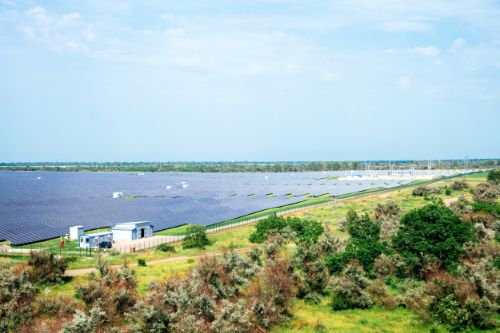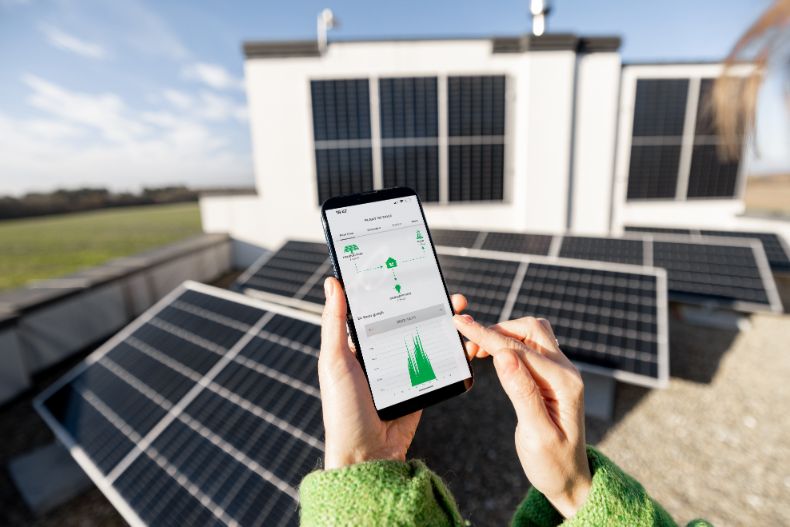Solar energy, as a prominent form of renewable energy, has emerged as a significant player in the global energy scenario. Its rise can be attributed to the critical role it plays in reducing the dependence on fossil fuels, a non-renewable source that significantly contributes to environmental degradation and climate change. Although the beneficial impacts of solar energy, such as lowering greenhouse gas emissions and decreasing pollution, are generally well recognized, it is essential to note that there are also environmental challenges to consider. This includes factors like the manufacturing and disposal of solar panels, land use issues, and the necessity for energy storage or robust grid infrastructure.
Solar energy has both positive and negative impacts on the environment. However, the benefits generally far outweigh the downsides, particularly when compared to conventional energy sources like fossil fuels.
- Reduction in Greenhouse Gas Emissions: Unlike burning fossil fuels, which release harmful gases into the atmosphere contributing to climate change, solar energy is a renewable, clean source of power. It produces energy without emitting greenhouse gases. Hence, it has a lower carbon footprint.
- Decrease in Air and Water Pollution: Solar energy doesn’t produce air pollutants or require water to generate electricity, which is a considerable advantage when compared to traditional energy sources like coal and natural gas power plants, which can lead to air and water pollution.
- Reduced Dependence on Non-renewable Energy Sources: Using solar energy reduces our dependence on finite resources like coal, oil, and natural gas. This helps to sustain the environment by preserving these resources and reducing the environmental damage caused by their extraction and use.
- Energy Production Matches Demand: In many parts of the world, energy demand is highest during the middle of the day – which is also when solar power production peaks. This can help reduce strain on the grid during peak times.
However, there are also some negative impacts of solar energy on the environment:
- Manufacturing and Disposal: The production of solar panels involves the extraction and processing of raw materials, which has an environmental impact. Additionally, panels can create waste at the end of their life if not disposed of or recycled properly. The use of rare minerals in some types of panels, and the energy-intensive process to refine these, can also have a significant environmental footprint.
- Land Use: Large-scale solar installations can require significant amounts of land, which may contribute to habitat destruction and impact local ecosystems.
- Energy Storage and Grid Infrastructure: Solar energy is intermittent, meaning it’s not always available when it’s needed (nighttime, cloudy days, etc.). Therefore, it often needs to be stored using batteries, or a robust grid infrastructure is needed to balance supply with demand. The production and disposal of batteries can have an environmental impact.
While solar energy does have some negative environmental impacts, it is overall a much cleaner alternative to traditional energy sources and plays a crucial role in mitigating climate change. The challenges that it does present, such as panel disposal and land use, are areas where further innovation and regulation can improve its environmental impact.
Positive Impact
In our pursuit of sustainable energy solutions, solar power emerges as a prominent contender with numerous environmental benefits. Solar energy, harnessing the inexhaustible power of the sun, offers a myriad of ecological advantages over traditional energy sources. Its notable impacts include a significant reduction in greenhouse gas emissions, contributing to global efforts against climate change. Furthermore, solar power helps decrease both air and water pollution, enhancing the health of ecosystems and organisms alike. Additionally, embracing solar energy allows us to reduce our dependence on finite, non-renewable resources like coal, oil, and natural gas, thereby conserving these resources and limiting the environmental damage from their extraction and use. Importantly, the production of solar energy aligns well with peak energy demand in many regions, offering an efficient solution that reduces strain on our power grids. As we delve into the details of these impacts, we get a clearer picture of the crucial role solar energy plays in shaping a sustainable future.
Reduction in Greenhouse Gas Emissions
 Solar energy is a form of renewable energy derived from the sun’s radiation. The process of harnessing and converting this energy into usable electricity via solar panels emits no greenhouse gases. Unlike conventional fossil fuels such as coal, oil, and natural gas, the generation of solar energy does not involve burning any substance.
Solar energy is a form of renewable energy derived from the sun’s radiation. The process of harnessing and converting this energy into usable electricity via solar panels emits no greenhouse gases. Unlike conventional fossil fuels such as coal, oil, and natural gas, the generation of solar energy does not involve burning any substance.
The burning of fossil fuels is a significant source of greenhouse gases, including carbon dioxide (CO2), methane (CH4), and nitrous oxide (N2O), which are primary contributors to global warming and climate change. When these gases are released into the Earth’s atmosphere, they trap heat from the sun, leading to an increase in the Earth’s average temperature, a phenomenon known as the greenhouse effect.
By contrast, solar energy systems, once installed and operational, produce electricity without the release of these harmful gases. As a result, the more we rely on solar energy to meet our power needs, the lower our collective carbon footprint becomes. This reduction in greenhouse gas emissions is crucial in our global efforts to mitigate climate change and its effects.
It’s also worth noting that while the manufacturing and transportation of solar panels do involve some greenhouse gas emissions, the life-cycle emissions of solar energy are much lower than those of fossil fuel-based energy. That is, when you account for the emissions from all stages of an energy source’s life (including production, usage, and disposal), solar energy still has a far smaller carbon footprint.
Decrease in Air and Water Pollution
 Traditional energy generation methods, particularly those that rely on the combustion of fossil fuels like coal and natural gas, contribute to both air and water pollution. They release harmful pollutants into the atmosphere, such as sulfur dioxide (SO2), nitrogen oxides (NOx), and particulate matter, which can have severe effects on human health and the environment. These pollutants can cause respiratory problems, heart disease, and other serious health issues in people. They also contribute to the formation of smog and acid rain, which can harm wildlife and ecosystems.
Traditional energy generation methods, particularly those that rely on the combustion of fossil fuels like coal and natural gas, contribute to both air and water pollution. They release harmful pollutants into the atmosphere, such as sulfur dioxide (SO2), nitrogen oxides (NOx), and particulate matter, which can have severe effects on human health and the environment. These pollutants can cause respiratory problems, heart disease, and other serious health issues in people. They also contribute to the formation of smog and acid rain, which can harm wildlife and ecosystems.
In contrast, solar energy systems, once installed, generate electricity without producing these harmful air pollutants. This reduction in air pollution can lead to improved public health and a cleaner, healthier environment.
Moreover, traditional power plants, especially thermoelectric plants, require enormous amounts of water for cooling purposes. This usage not only depletes water resources but can also lead to water pollution if chemicals or heat used in the power generation process are discharged into water bodies, causing damage to aquatic life and ecosystems.
Solar photovoltaic (PV) systems, on the other hand, require no water to generate electricity. This virtually eliminates the water pollution associated with energy production and makes solar energy a more sustainable option in regions where water resources are scarce or need to be conserved.
The switch to solar energy can result in significant reductions in both air and water pollution, making it a clean, environmentally friendly energy source. By adopting solar energy, we can protect our water resources and improve the quality of our air, promoting healthier lives and ecosystems.
Reduced Dependence on Non-renewable Energy Sources
 Non-renewable energy sources, such as coal, oil, and natural gas, are finite resources that were formed over millions of years from the remains of ancient plants and animals. Once these resources are consumed, they cannot be replenished on a human timescale. In contrast, solar energy is derived from the sun, a resource that is essentially inexhaustible on a human timescale.
Non-renewable energy sources, such as coal, oil, and natural gas, are finite resources that were formed over millions of years from the remains of ancient plants and animals. Once these resources are consumed, they cannot be replenished on a human timescale. In contrast, solar energy is derived from the sun, a resource that is essentially inexhaustible on a human timescale.
Relying heavily on non-renewable energy sources poses two primary problems. First, the extraction and use of these resources often lead to significant environmental damage. Mining for coal, for instance, can result in habitat destruction, soil erosion, and water contamination. Similarly, the drilling for oil and natural gas can cause oil spills and other forms of pollution that harm ecosystems and wildlife.
Second, as these resources become more scarce, they will become increasingly difficult and expensive to extract. This could lead to economic instability and energy shortages in the future.
By transitioning to solar energy, we can reduce our dependence on these finite, non-renewable resources. Not only does this help preserve these resources for future generations, but it also minimizes the environmental harm associated with their extraction and use.
Furthermore, solar energy can provide energy security and resilience. Because it relies on the sun, which is widely distributed and reliable, it can reduce a nation’s reliance on imported energy resources, thereby improving its energy independence.
The use of solar energy is a vital strategy for preserving non-renewable resources, reducing environmental degradation, and enhancing energy security. By reducing our dependence on non-renewable energy sources and embracing renewable alternatives like solar, we are taking a significant step towards a more sustainable and resilient energy future.
Energy Production Matches Demand
 Electricity demand typically peaks during the daytime, particularly in the late morning and early afternoon. This is when businesses are operating, air conditioners are running in homes and offices, and overall energy use is high. Traditional power grids must be able to handle these peak demand periods, which can put a strain on infrastructure and increase the risk of blackouts or brownouts.
Electricity demand typically peaks during the daytime, particularly in the late morning and early afternoon. This is when businesses are operating, air conditioners are running in homes and offices, and overall energy use is high. Traditional power grids must be able to handle these peak demand periods, which can put a strain on infrastructure and increase the risk of blackouts or brownouts.
Solar energy has a unique advantage in this respect. The production of solar power coincides with the sun’s availability, which means it typically peaks during the middle of the day. This is often exactly when electricity demand is highest. By supplying additional power to the grid during these peak times, solar energy can help alleviate strain on the grid.
In addition, in many regions, especially those with high air conditioner use, the electricity demand is not just high during the day, but specifically on sunny, hot days. Since these are the same conditions that lead to high solar power output, solar energy can be particularly effective at meeting peak demand in these regions.
This alignment of solar power production with peak energy demand also has economic benefits. It can reduce the need for expensive “peaker” power plants, which are only activated during times of high demand and typically run on fossil fuels. Therefore, solar power can contribute to more stable electricity prices and lower overall costs for electricity generation.
The fact that solar energy production matches peak energy demand is a significant benefit that can contribute to grid stability, efficient energy use, and cost savings. It underscores the critical role of solar power in a balanced, resilient, and sustainable energy system.
Negative Impact
Despite the numerous advantages of solar energy, it’s essential to also consider the challenges and potential negative environmental impacts. The process of manufacturing solar panels necessitates the extraction and processing of raw materials, an activity that inevitably affects the environment. If not managed properly, solar panels can generate waste at the end of their life, contributing to growing e-waste concerns. The utilization of rare minerals in some panels, coupled with energy-intensive refining processes, can amplify this environmental footprint. Furthermore, the land requirements for large-scale solar installations pose an additional challenge, potentially leading to habitat destruction and disturbances in local ecosystems. Finally, the intermittent nature of solar energy necessitates energy storage, often in the form of batteries, or demands robust grid infrastructure to balance supply and demand. The production and disposal of batteries, similar to solar panels, carry their environmental impacts. As we proceed, we will explore these complexities in detail to better understand the full environmental context of solar energy.
Manufacturing and Disposal
 The production of solar panels involves the extraction and processing of various raw materials, such as silicon, silver, and rare minerals like indium and gallium in the case of thin-film solar cells. The mining of these materials can lead to habitat destruction, soil erosion, and water contamination. The refining process can be energy-intensive and involve chemicals that, if not handled properly, can lead to environmental damage.
The production of solar panels involves the extraction and processing of various raw materials, such as silicon, silver, and rare minerals like indium and gallium in the case of thin-film solar cells. The mining of these materials can lead to habitat destruction, soil erosion, and water contamination. The refining process can be energy-intensive and involve chemicals that, if not handled properly, can lead to environmental damage.
Moreover, solar panels have a finite lifespan, typically around 25-30 years. At the end of their life, if not properly disposed of or recycled, they can create electronic waste (e-waste). This e-waste can contain hazardous materials such as lead and can pose environmental and health risks if not managed properly.
However, it’s crucial to note that the solar industry is increasingly focusing on panel recycling and end-of-life management. Many components of solar panels can be recycled, including metals and glass, reducing the need for new raw materials and minimizing waste.
Additionally, advances in technology are reducing the amount of rare and precious materials needed for solar cells, and research is ongoing into new types of solar cells that use more abundant and environmentally friendly materials.
While the manufacturing and disposal of solar panels do have an environmental impact, it is significantly less than the impact of traditional energy sources. Furthermore, ongoing advancements in technology and improved recycling practices are likely to reduce this impact even further in the future. Despite these challenges, solar energy remains a key part of the solution to our global energy needs and the fight against climate change.
Land Use
 Solar farms, particularly those intended to generate large amounts of power, can require significant amounts of land. The development of this land for solar installations can lead to habitat destruction and loss of biodiversity if not carefully planned and managed. Additionally, the construction and maintenance activities associated with these installations can disrupt local ecosystems.
Solar farms, particularly those intended to generate large amounts of power, can require significant amounts of land. The development of this land for solar installations can lead to habitat destruction and loss of biodiversity if not carefully planned and managed. Additionally, the construction and maintenance activities associated with these installations can disrupt local ecosystems.
It is also worth noting that land use for solar farms can compete with other uses such as agriculture or housing. In densely populated areas or places with high land costs, this can be a significant challenge.
However, several strategies can mitigate these impacts. For instance, solar installations can be combined with agricultural activities in a setup known as “agrivoltaics” or “dual-use farming”. This allows for the simultaneous production of crops and solar power on the same land, reducing competition for land resources.
Moreover, solar panels can be installed on rooftops, parking lots, and other built environments, generating power without requiring any additional land use. Such distributed solar installations not only save land but also reduce transmission losses since electricity is generated close to where it is used.
Lastly, careful planning and siting of solar farms can help minimize their ecological impact. This includes placing them on previously disturbed or low-value lands, or in areas with low biodiversity.
While land use is indeed a concern for large-scale solar installations, various strategies can help mitigate these impacts. With careful planning and innovative approaches, it’s possible to generate solar power at a large scale while still preserving and respecting our natural landscapes and ecosystems.
Energy Storage and Grid Infrastructure
 Solar energy production is dependent on sunlight, making it an intermittent source of power. Solar panels generate electricity during the day but not at night, and their output can be affected by weather conditions like cloud cover. Therefore, for solar power to be a reliable source of electricity, it needs to be either stored for later use or supplemented with other energy sources.
Solar energy production is dependent on sunlight, making it an intermittent source of power. Solar panels generate electricity during the day but not at night, and their output can be affected by weather conditions like cloud cover. Therefore, for solar power to be a reliable source of electricity, it needs to be either stored for later use or supplemented with other energy sources.
Energy storage, often in the form of batteries, enables excess solar power produced during the day to be stored and then used when solar power generation is low or non-existent, such as during the night or on cloudy days. However, the production and disposal of batteries can have environmental impacts. Battery manufacturing is energy-intensive, involves potentially harmful materials, and batteries at the end of their life can contribute to waste if not properly recycled.
Meanwhile, robust grid infrastructure is needed to balance supply and demand when dealing with intermittent power sources like solar. This can involve a mix of different energy sources or technologies, and possibly the use of smart grid technologies that can respond dynamically to changes in electricity demand and supply.
Importantly, advances are being made in both energy storage and grid management technologies, aimed at reducing their environmental impact and improving their effectiveness. Battery technologies are continually improving, becoming more efficient, lasting longer, and becoming easier to recycle. In addition, techniques for grid management are improving, allowing for better integration of renewable energy sources.
While the intermittent nature of solar energy and the need for energy storage or a robust grid infrastructure present challenges, technological advancements are helping to mitigate these issues. Despite these challenges, solar energy remains a critical component of a sustainable and low-carbon energy future.
Solar energy offers a much-needed alternative to traditional energy sources. Despite the challenges associated with solar energy, such as land use, manufacturing impacts, and energy storage, the environmental benefits substantially overshadow the negatives. It plays an instrumental role in curtailing greenhouse gas emissions, lowering air and water pollution, and reducing reliance on non-renewable resources. Nevertheless, the journey towards a sustainable future requires us to continue improving and innovating within the solar industry, especially in areas like recycling and waste management, grid infrastructure, and minimal impact land use. As we move forward, it is clear that solar energy will continue to be an essential player in the fight against climate change.
